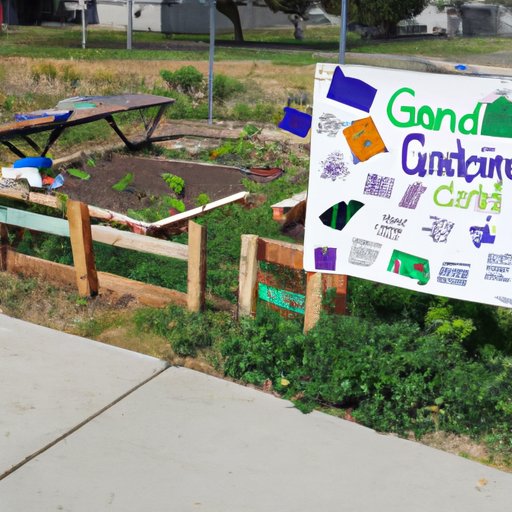Introduction
A community garden is an area of land that is used by a group of people to grow and cultivate food, flowers, or other plants. These gardens are often found in city neighborhoods, schools, churches, and parks, and they provide an opportunity for people to come together and learn about sustainable gardening practices. Establishing a community garden can also help to beautify a neighborhood, strengthen bonds within the community, and provide access to fresh, healthy food.

Identifying Potential Locations for a Community Garden
The first step in starting a community garden is to identify a potential location. Before settling on a site, it’s important to research local regulations and requirements. Depending on the location of the garden, there may be zoning laws or other regulations that need to be taken into consideration. Additionally, it’s important to make sure that the garden will be located in a safe, open space that is accessible to everyone in the community.
When choosing a potential location, there are several factors to consider. The size of the garden should be determined based on the number of people who plan to participate, as well as the types of plants that will be grown. It’s also important to consider the amount of sunlight available, the soil quality, and the availability of water. It’s best to choose a location that has adequate sunlight and good soil quality, as these two factors are essential for a successful garden.
Developing a Plan of Action
Once a potential location has been identified, the next step is to develop a plan of action. This plan should include a vision for the garden, objectives and goals, and rules and guidelines. Creating a vision statement helps to set the direction for the garden, and outlining objectives and goals helps to ensure that the garden’s purpose is clear. Establishing rules and guidelines helps to ensure that the garden is maintained properly, and that all participants follow the same set of standards.
Securing Funding and Resources
Securing funding and resources is an important step in starting a community garden. There are several types of funding available, including grants, donations, and crowdfunding campaigns. It’s important to research the different types of funding options available in order to determine which one is best for your particular project. Additionally, it’s important to utilize existing resources, such as donated materials and volunteer labor, to help reduce costs.
Recruiting Volunteers and Members
In order to have a successful community garden, it’s important to recruit volunteers and members. Promoting the garden is key to finding volunteers and members, and there are several ways to do this. Social media is a great way to reach potential volunteers and members, as well as local newspapers, radio stations, and even flyers posted around town. Once volunteers and members have been recruited, it’s important to provide them with training and support in order to ensure the success of the garden.

Creating and Promoting a Gardening Space
After recruiting volunteers and members, the next step is to create and promote a gardening space. This involves designing the garden, planting the plants, and maintaining the garden. Designing the garden includes creating pathways, establishing beds, and planning the layout of the plants. Planting the plants includes selecting the type of plants, determining the placement of the plants, and preparing the soil. Maintenance includes watering the plants, weeding, and monitoring the health of the plants.
Conclusion
Starting a community garden is a great way to bring people together and foster a sense of community. With the right planning and resources, a community garden can be a successful and rewarding endeavor. By researching local regulations and requirements, developing a plan of action, securing funding and resources, recruiting volunteers and members, and creating and promoting a gardening space, anyone can start a successful community garden.
(Note: Is this article not meeting your expectations? Do you have knowledge or insights to share? Unlock new opportunities and expand your reach by joining our authors team. Click Registration to join us and share your expertise with our readers.)
